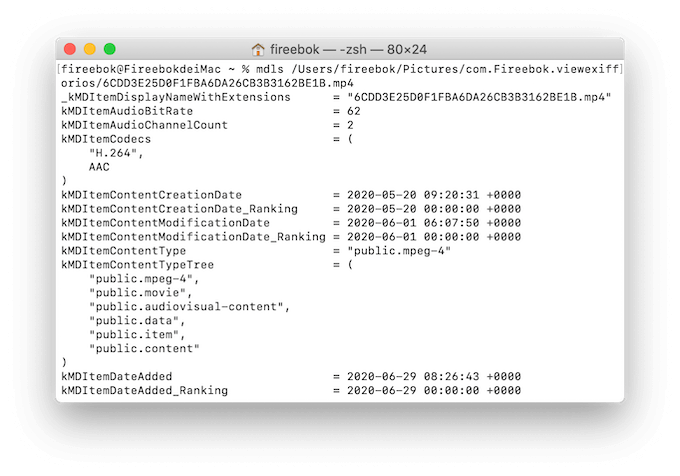

- MAC COMMAND LINE LIST PICTURES BASED ON EXIF DATA MAC
- MAC COMMAND LINE LIST PICTURES BASED ON EXIF DATA WINDOWS
Warning! We are moving the data back to there original place. replace “ c:\Users\THG\Desktop” with “ D:\rescued”). Use “Find & Replace” in your text editor to change the target location (e.g. If you changed the location of the target in the LRecoverMove script, you must also change it in this script. To the first line and save the file as LRecoverHierarchy. To the first line and save the file as LRecoverHierarchy.bat. Copy the contents of column E into a text editor (using copy & paste) (This took a long time on my machine with OpenOffice 3.2). Save the document again as text file, close the document and reopen it. (Ignore the fact that there are a lot of duplicate entries.) Expand this formula to all other D rows.įinally we build the script in E3 with the formula:įor Mac. The result should be the path to the file without the file name itself (e.g.
MAC COMMAND LINE LIST PICTURES BASED ON EXIF DATA WINDOWS
Go to the first empty column (D3) and enter for windows the formula: This script will be created in the same way as LRecoverMove script. Therefore we have to create the target directories first! LRecoverHierarchy The move process will fail, if the target directory does not exists. It will move all recovered files back to there original place. replace “c:\Users\THG\Desktop” with “D:\rescued”).
You might want to change the target location of the move process if the target is your broken drive! Use “Find & Replace” in your text editor to change the target location (e.g.

To the first line and save the file as LRecoverMove.sh. To the first line and save the file as LRecoverMove.bat.

Copy the contents of column C into a text editor (using copy & paste) (This took a long time on my machine with OpenOffice 3.2). In OpenOffice you can overwrite this setting in the “Tools->AutoCorrect Options->Custom Quotes” settings by removing the check mark before the “Replace” option.Ĭopy the formula to the remaining empty rows. May be your ‘ “’ will be replace by some other quotes. Please, take care of the number of quotes and spaces! If you want a quote in string in OpenOffice you have to write two quotes!
MAC COMMAND LINE LIST PICTURES BASED ON EXIF DATA MAC
Go to the first empty column (C3 in my case) and enter the following formula (on mac replace move with mv): csv file in OpenOffice (confirm all questions on import). Activate the “Save cell content as show” checkbox to save your custom date format in the text file and accept all other options.Ĭlose the file (ignore save message) and open the exported. Enter the following line in your command lineĮxiftool "-FileNameSave as”). Open a command prompt and go to topmost folder where all your recovered files are stored. I expect that all files are stored in one single directory called d:\hdd_recover without any subdirectories. Therefore move all recovered file into one directory. The renaming process is much easier when all files are stored in one directory. Do the following steps only on these backups! NEVER WORK ON YOUR RECOVERED DRIVE YOU MIGHT LOOSE ALL YOUR FILES. Make a backup of your exiting Lightroom catalog and a backup copy off all recovered images. Here are two screenshots: one of Lightroom with “missing photo” icons andĪs you can see, all files in the recovery folder have arbitrary names are distributed over different folders.


 0 kommentar(er)
0 kommentar(er)
